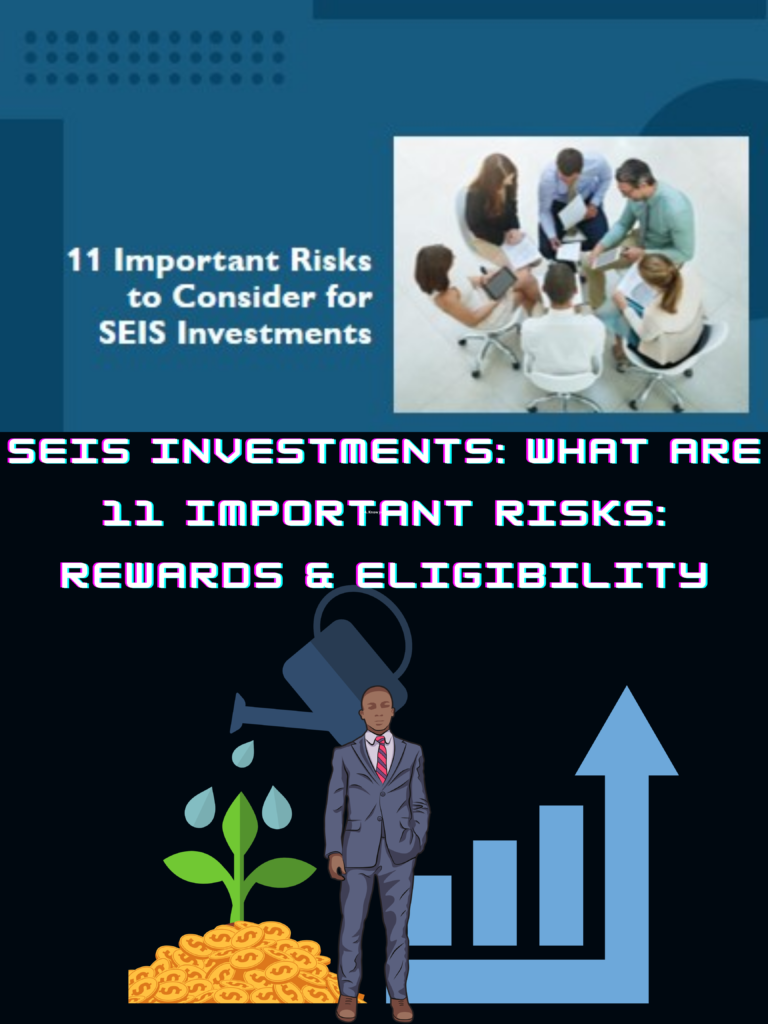Introduction:
Exploring the intricacies of Seed Enterprise Investment Scheme (SEIS) ventures reveals a dynamic interplay of potential risks and benefits. In this article, we delve into the 11 critical aspects tied to SEIS Investments, shedding light on what investors should be mindful of in this tax-saving journey.

Unveiling the SEIS Investment Landscape:
The Seed Enterprise Investment Scheme (SEIS) is a tax investment initiative fostering support for small, early-stage UK companies. While promising tax relief on income and capital gains, it introduces limited safeguards for capital losses. Here, we dissect the risks integral to SEIS investments.
11 Potential Risks of SEIS Investments (Seed Enterprise Investment Scheme):
Potential for Loss:
- Startup investments inherently carry the risk of business failure, especially pronounced in early-stage companies lacking a proven track record.
Illiquidity:
- SEIS investments may lack a market, potentially tying up capital for an extended period without readily available avenues for selling shares.
Limited Capital Loss Relief:
- Despite tax relief on gains, SEIS provides limited solace for capital losses, restricting avenues for recovery in case of investment failure.
Lack of Diversification:
- Focusing on a single SEIS-qualifying company amplifies risks, linking the fate of your investment solely to the fortune of that entity.
No Guarantee of Returns:
- SEIS investments are long-term and may not yield returns for at least three years, with success far from guaranteed.
High Risk: SEIS Investments
- SEIS investments are inherently high-risk, tailored for experienced investors ready to navigate potential capital losses.
No Track Record: SEIS Investments
- Early-stage companies lack a proven track record, making assessments of their potential success reliant on the company’s business plan and management team.
Limited Information: SEIS Investments
- Early-stage companies may offer scant information, necessitating reliance on the company’s business plan and management team for informed decision-making.
Lack of Control: SEIS Investments
- Investing in a portfolio or fund offers diversification but reduces control and visibility over invested capital, which may be a disadvantage for investors seeking more control.
No Dividends: SEIS Investments
- Early-stage companies may not pay dividends, disadvantaged investors seeking a regular income stream.
No Protection: SEIS Investments
- SEIS investments lack the safety net of the Financial Services Compensation Scheme (FSCS), heightening risks, especially for early-stage companies.
Conclusion: SEIS Investments
In conclusion, SEIS investments provide enticing tax advantages but carry inherent risks. Investors should be prepared for potential losses and approach SEIS ventures with informed decision-making to mitigate exposure to risk.
Additional Insights: SEIS Investments
SEIS Investment Qualification Criteria:
- Established in the UK.
- Fully independent.
- Under two years old.
- Unquoted before SEIS.
- Within a qualifying trade.
- Fewer than 25 employees.
SEIS Investments Application Process:
- Check eligibility.
- Apply for Advance Assurance from HM Revenue & Customs.
- Issue shares to investors.
- Submit a compliance statement within two years.
- Investors can claim up to 50% income tax relief on investments.
SEIS Investments Benefits:
- Income tax relief up to 50% on investments.
- Capital gains tax relief with a three-year exemption.
- Loss relief for sold SEIS shares at a loss.
- Inheritance tax relief with no tax on shares held for at least two years.
- Potential for increased return on investment.
- Diversification of investment portfolio to reduce overall risk.
While success stories highlight SEIS’s potential, prospective investors should conduct thorough assessments before venturing into this tax-saving initiative.
Conclusion:
SEIS investments blend enticing tax benefits with inherent risks, demanding a cautious approach. The guide outlines 11 key risks, from business failure to illiquidity, emphasizing the need for strategic decision-making. Despite challenges, SEIS offers a unique opportunity to support early-stage UK businesses. Investors must navigate the stringent criteria and application process, recognizing SEIS as a tool for experienced players. The scheme’s benefits, including tax relief and diversification, underscore its potential for positive returns. In essence, successful SEIS investments hinge on informed decisions, financial acumen, and a readiness for the nuanced world of early-stage ventures.
Answer Covered for People also ask
1.What are the benefits of SEIS and EIS for investors?
2.What is the SEIS 4 month rule?
Ans. The SCEC (part of HMRC) issues a company with SEIS3s. This happens when it has been trading for the period of four months or if it has spent 70% of its total investment. The company then qualifies an SEIS3 form on to each investor, who completes and submits it as part of their tax return.
3.Who Cannot invest in SEIS?
4.What is the difference between SEIS and EIS?
Ans. SEIS is created for startups in their early years whereas EIS is for further more established companies.
5.What are the conditions for SEIS tax relief?
6.What is the SEIS limit?
Disclaimer
This article has been created on the basis of internal data, information available publicly, and other reliable sources to be believed. The article may also include information which are the personal views/opinions of the authors. The information included in this article is for general, educational, and awareness purposes only and is not a full disclosure of every material fact.
All the information on this website i.e. World Virtual CFO – is published in good faith and for general information purposes only. World Virtual CFO does not make any warranties about the completeness, reliability, and accuracy of this information. These are my views for only information purposes. Any action you take upon the information you find on this website (World Virtual CFO), is strictly at your own risk. World Virtual CFO will not be liable for any losses and/or damages in connection with using our website. For details please refer to our disclaimer page.
Dr. Dinesh Sharma is an award-winning CFO and AI strategist with over two decades of experience in financial leadership, digital transformation, and business optimization. As the founder of multiple niche platforms—including WorldVirtualCFO.com—he empowers professionals and organizations with strategic insights, system structuring, and innovative tools for sustainable growth. His blogs and e-books blend precision with vision, making complex financial and technological concepts accessible and actionable.